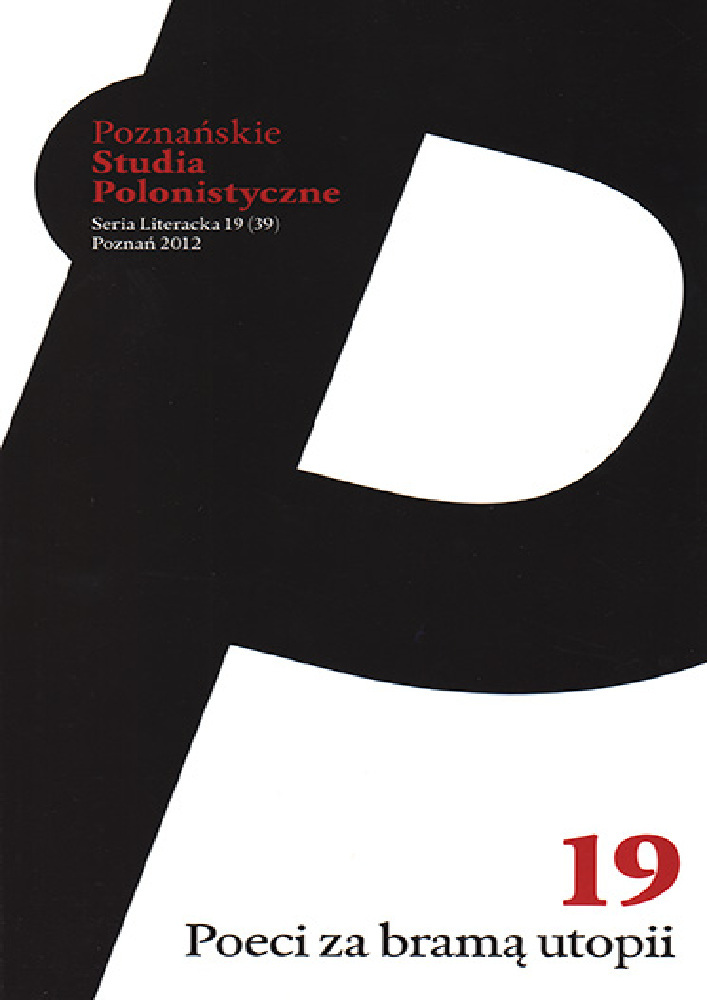Abstrakt
The starting point for the interpretation of the poem Płyn Lugola, [Lugol’s solution] written by B. Zadura, is the rift between the classical form of the sonnet and the title that prompts the interventionist character of the poem and that indicates journalistic involvement in and the implications of the events in Chernobyl. This in turn leads to identification of further structural tensions and dissonances (in the verse course, at the level of imaging and in shaping the mood of the poem). The descriptive category for the essence of the composition and underlined overtones of the work is the sublime, in particular as it is viewed by modern aesthetics (proposed by Lyotard, Derrida, but also Burke). What surfaces is the microscale of imaging clashed with the macroscale phenomena formalized in lyrical situation, violation of the substance of the world, stability encroached by liquidity. A particularly validated layer of the work is the sound structure of the poem: in the finely and precisely controlled instrumental line, almost equivalent to the anagram, connotes the word “Chernobyl”, though the word is not expressed explicitly in the text. The interpretation intends to prove that the stake here is the articulation of sublimity charged and permeated with a metapoetic reflection – and that “the most important is, at the same time, the most difficult to describe”.
Bibliografia
Baka J., Młodym uwaga, w: idem, Poezje. Uwagi rzeczy ostatecznych i złości grzechowych. Uwagi śmierci niechybnej, oprac. R. Grześkowiak, M. Adamiec, Gdańsk 2001.
Burke E., Dociekania filozoficzne o pochodzeniu naszych idei wzniosłości i piękna, przeł. P. Graff, Warszawa 1968.
Derrida J., Co to jest terroryzm?, przeł. J. Szczygieł, „Le Monde Diplomatique” IV 2004.
Kapuściński R., Świat straszny i wielki, „Gazeta Wyborcza” 26–27 I 2002.
Lyotard J.-F., Wzniosłość i awangarda, przeł. M. Bieńczyk, „Teksty Drugie” 1996, nr 2/3.
Nawarecki A., Czarna mikrologia, w: Skala mikro w badaniach literackich, red. A. Nawarecki, M. Bogdanowska, Katowice 2005.
Przybylski R., Między śmiercią a tekstem, w: idem, To jest klasycyzm, Warszawa 1978.
Zadura B., Płyn Lugola, w: idem, Wiersze zebrane, t. 2, Wrocław 2005.
Licencja
Autorzy
Autorzy tekstów przyjętych do publikacji w czasopiśmie „Poznańskie Studia Polonistyczne. Seria Literacka” są zobowiązani do wypełnienia, podpisania i odesłania na adres redakcji umowy o udzielenie nieodpłatnej licencji do utworów, z zobowiązaniem do udzielania sublicencji CC.
Zgodnie z umową, autorzy tekstów opublikowanych w czasopiśmie „Poznańskie Studia Polonistyczne. Seria Literacka” udzielają Uniwersytetowi im. Adama Mickiewicza w Poznaniu niewyłącznej i nieodpłatnej licencji oraz zezwalają na użycie sublicencji Creative Commons Attribution-NoDerivatives 4.0 International (CC BY-ND 4.0).
Autorzy zachowują prawa do dalszego, swobodnego rozporządzania utworem.
Użytkownicy
Zainteresowani użytkownicy internetu uprawnieni są do korzystania z utworów opublikowanych od 2016 roku w „Poznańskich Studiach Polonistycznych. Serii Literackiej” pod następującymi warunkami:
- uznanie autorstwa – obowiązek podania wraz z rozpowszechnionym utworem, informacji, o autorstwie, tytule, źródle (odnośniki do oryginalnego utworu, DOI) oraz samej licencji;
- bez tworzenia utworów zależnych – utwór musi być zachowany w oryginalnej postaci, nie można bez zgody twórcy rozpowszechniać np. tłumaczeń, opracowań.
Do wszystkich tekstów opublikowanych przed 2016 r. prawa autorskie są zastrzeżone.
Inne
Uniwersytet im. Adama Mickiewicza w Poznaniu zachowuje prawo do czasopisma jako całości (układ, forma graficzna, tytuł, projekt okładki, logo itp.).
